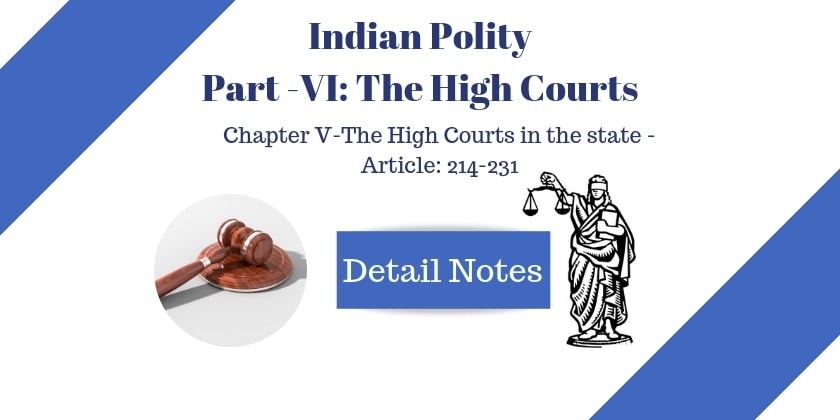Part 6 -The High Courts
Chapter V of Part 6 (The State) of the Indian Constitution deals with The High Courts of the states, under Article 214-231 discuss High Courts of the states and its power.
Creation of High Court:
During the tenure of the last Governor-General Lord Canning from the East India Company, Indian High Court Act was passed in British Parliament under the Indian High Courts Act of 1861. The United Kingdom Parliament to authorize the Crown to make a High Court in the Indian colony. In 1862, Queen Victoria made the High Courts in, Patents, Calcutta, Madras, and Bombay.
Each state will have a high court under article 214. But the Parliament has the power to establish a general high court for two or more states. The High Court is on the top of the judiciary in the state. ‘participatory consultative process’ for selecting the best and most suitable persons available for appointment, and all the constitutional functionaries must perform this duty collectively with a view primarily to reach an agreed decision, subserving the constitutional purpose, so that the occasion of primacy does not arise.
Total number of High Court at Present in India:
There are 25 High Courts at the State and Union Territory of India at present. 1st January 2019 Andhra Pradesh have a separate High Court at Amaravati. Before this Andhra Pradesh and Telangana have had a common High Court situated at Hyderabad.
- The Calcutta High Court is the oldest high court in the country, established on 2 July 1862.
- Newest High Court Andhra Pradesh high Court at Amaravati.
- Allahabad High Court is the biggest High Court in India.
Appointment and Qualification of High Court Judges:
Each High Court could consist of a chief justice and up to 15 judges. Judges may be selected from Barrister (with 5 years of experience), Civil Servants (with 3 years of experience as a District Judge), Small reasons Court Judges or Sudder Amin (with 5 years of experience) or petitioner lander court or high court (with experience of 05 years).
In every High Court, there is a Chief Justice and many other judges whose number is defined by the President of India.
Qualifications:
1. He should be a citizen of India.
2. He should have been
i- A judge for 10 years of Subordinate court under the Judicial Service of the State
ii- an Advocate for 10 years in a High Courts in India under article 217.
Tenure of High Court Judges:
1. Originally the age of the retirement of the judges of the High Courts was fixed at 60 but it was raised to 62 in 1963 according to the 15th amendment of the Constitution.
2. Any dispute regarding the age of judge of High Court is decided by President in consultation with Chief Justice of India.
Removal of High Court Judges:
1. A judge may leave his office by resigning to the name of President.
2. A judge of a High Court may also be removed like a judge of the Supreme Court.
3. A judge of High Court may be removed by the President if the Parliament passes a motion against him by an absolute majority and 2/3rd majority of the members present and voting, both the Houses sitting separately.
Salary of High Court Judges:
Salary of High Court Judges from the consolidated fund of State:
• Chief Justice – Rs. 90,000
• Others judges – Rs.80,000
Oath – Before Governor (Unlike before President as in case of Supreme Court).
Powers and Functions of High Court judge:
1. Original Jurisdiction: The original jurisdiction of High Court extends to matters of admiralty, matrimonial, contempt of court and cases ordered to be transferred to High Court by the lower court.
2. Appellate Jurisdiction: All HighCourts entertain appeals in civil & criminal cases from their subordinate courts. The High Court can hear appeals in civil cases if the amount involved in the case is at least Rs. 5000. The High Court in criminal cases hears the appeal in which the accused has been sentenced to four years imprisonment by the Sessions Judge.
3. Writ Jurisdiction: Jurisdiction to issue writs under High Court is larger than the Supreme Court.
The important article under High Court:
1. Article 214: High Courts for States
2. Article 215: High Courts to be courts of record
3. Article 216: Constitution of High Courts
4. Article 217: Appointment and conditions of the office of a Judge of a High Court
5. Article 218: Application of certain provisions relating to the Supreme Court to High Courts
6. Article 219: Oath or affirmation by Judges of High Courts
7. Article 220: Restriction on practice after being a permanent Judge
8. Article 221: Salaries, etc., of Judges
9. Article 222: Transfer of a Judge from one High Court to another
10. Article 223: Appointment of acting Chief Justice
11. Article 224: Appointment of additional and acting Judges
12. Article 224A: Appointment of retired Judges at sittings of High Courts
13. Article 225: Jurisdiction of existing High Courts
14. Article 226: Power of High Courts to issue certain writs
15. Article 227: Power of superintendence over all courts by the High Court
16. Article 228: Transfer of certain cases to High Court
17. Article 229: Officers and servants and the expenses of High Courts
18. Article 230: Extension of jurisdiction of High Courts to Union territories
19. Article 231: Establishment of a common High Court for two or more States

